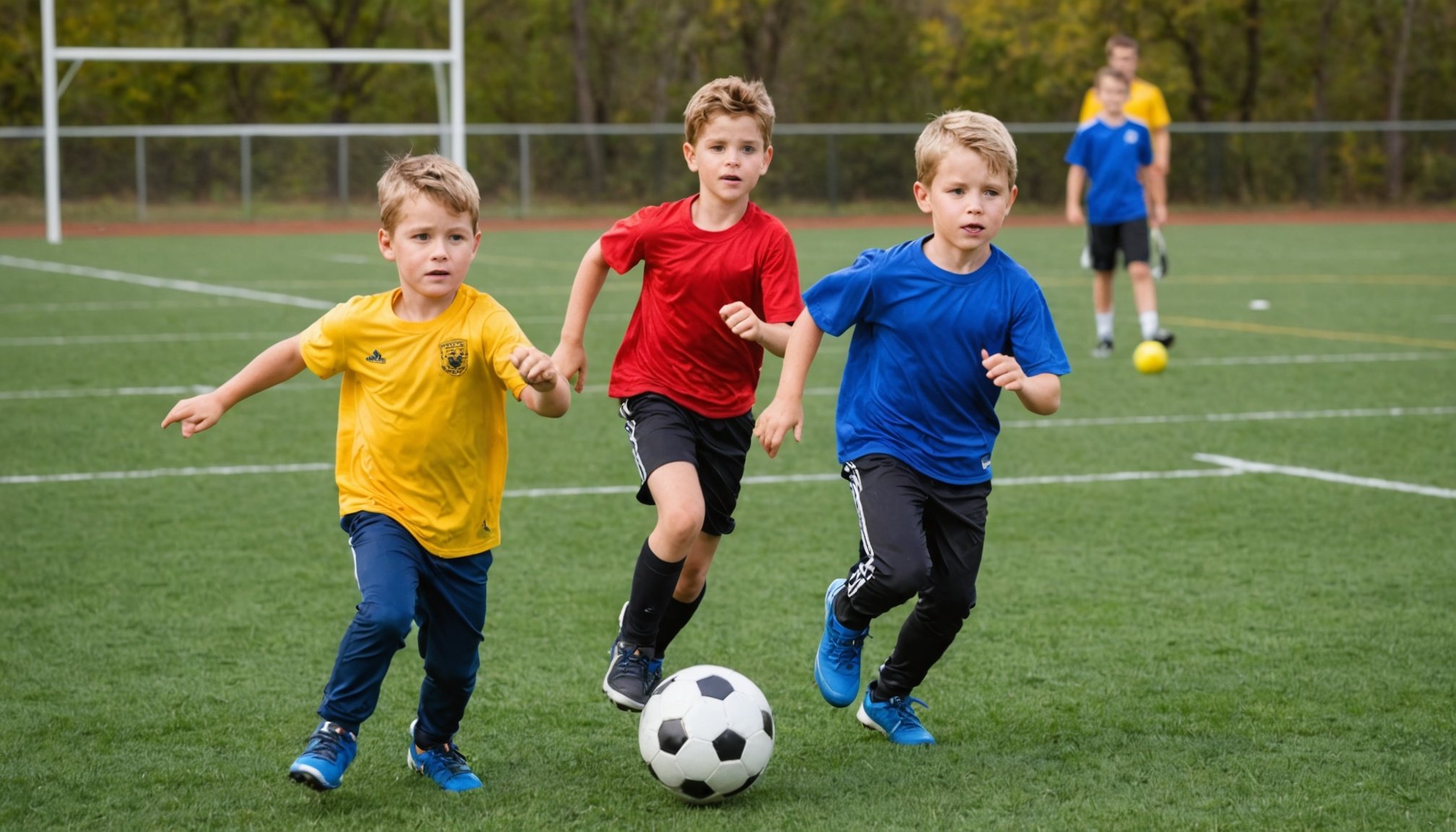Unleashing Potential: How Multi-Sport Participation Enhances Children’s Motor Skill Development
The Importance of Early Motor Skill Development
When it comes to the development of young children, motor skills are a crucial aspect that lays the foundation for their overall physical, social, and cognitive growth. Motor skills, which include both fine and gross motor abilities, are essential for everyday activities, from simple tasks like dressing and feeding to more complex actions such as playing sports or engaging in creative play.
In the context of children’s development, participating in multiple sports can be a game-changer. Here’s why:
Also read : Enhancing formula 1 reaction times: unleashing the power of non-invasive brain stimulation
Diverse Movement Experiences
Engaging in different sports helps children develop a broad range of motor skills. Each sport requires different movements, whether it’s the agility needed in soccer, the hand-eye coordination in tennis, or the endurance in swimming[3].
For instance, a child who participates in soccer will improve their running, kicking, and dribbling skills, while a child who plays basketball will enhance their jumping, throwing, and catching abilities. This diversity in movement experiences is key to well-rounded motor skill development.
This might interest you : Elevating athlete recovery: how collaborative interdisciplinary teams transform injury rehabilitation for professional football players
Benefits of Multi-Sport Participation
Enhanced Motor Skills
Multi-sport participation is proven to enhance motor skills in several ways:
- Coordination and Balance: Different sports require different types of coordination and balance. For example, gymnastics helps in developing overall body coordination, while sports like basketball and soccer improve balance and agility[3].
- Strength and Endurance: Participating in various sports helps build strength and endurance. Swimming, for example, is excellent for building overall muscle strength, while running in sports like soccer and football enhances cardiovascular endurance.
- Fine Motor Skills: Sports that involve handling a ball, such as tennis or baseball, improve fine motor skills like hand-eye coordination and dexterity.
Here is a detailed list of how different sports contribute to motor skill development:
- Soccer:
- Running and kicking
- Dribbling and ball control
- Agility and quick changes in direction
- Basketball:
- Jumping and throwing
- Catching and passing
- Quick movements and changes in direction
- Swimming:
- Overall muscle strength
- Endurance and cardiovascular fitness
- Coordination and timing
- Tennis:
- Hand-eye coordination
- Fine motor skills (racket handling)
- Agility and quick movements
Reduced Risk of Injuries
Early sports specialization, where a child focuses on a single sport from a young age, has been linked to increased risks of injuries and delayed motor development. In contrast, multi-sport participation reduces these risks significantly.
According to Dr. Travis Frantz, an orthopedic surgeon at Texas Health Orthopedic Specialists, “Early sport specialization nearly doubles the risk of injuries compared to multi-sport participation. This is particularly concerning in young athletes whose bodies are still developing”[2].
Promoting Social Skills and Enjoyment
Multi-sport participation is not just beneficial for physical development but also for social and emotional growth. Here are some ways it promotes social skills and enjoyment:
- Teamwork and Communication: Many sports, especially team sports, require children to work together, communicate effectively, and support each other.
- Friendship and Social Bonds: Participating in multiple sports allows children to interact with different groups of peers, fostering friendships and social bonds.
- Enjoyment and Motivation: When children are allowed to explore various sports, they are more likely to find activities they genuinely enjoy, which keeps them motivated and engaged.
The Risks of Early Sports Specialization
While the idea of early sports specialization might seem appealing, especially for parents hoping to secure college scholarships or professional careers for their children, the reality is far from beneficial.
Delayed Motor Development
Focusing exclusively on one sport can disrupt overall motor development. Dr. Frantz notes, “Numerous studies have shown that early sport specialization slows overall motor development, increases the risk of injuries both in the short and long term, and creates higher rates of burnout and mental health consequences”[2].
Increased Injury Risks
The repetitive nature of performing the same sport-specific skills places tremendous stress on growing bodies, leading to overuse injuries and long-term musculoskeletal issues. For example, young baseball pitchers throwing for more than 8 months per year have a significantly increased risk of requiring shoulder or elbow surgery[2].
Mental Health Consequences
Early sports specialization can also lead to mental health issues such as burnout and decreased enjoyment of the sport. Dr. Frantz emphasizes, “The sport should be fun and engaging, especially for younger athletes, as enjoyment is key to maintaining motivation”[2].
Finding the Right Balance in Youth Sports
To ensure that your child’s sports experience is balanced and beneficial, here are some tips:
Prioritize Rest and Recovery
Rest is essential for growing bodies, especially those under the strain of repetitive motions. Ensuring your child takes breaks from sport-specific activities, especially during overlapping seasons, is crucial to their health.
Encourage Cross-Training
Encourage participation in different sports or activities that work with varying muscle groups. Cross-training not only reduces injury risks but also enhances overall athletic performance.
Keep It Fun
The primary goal should always be to keep the experience enjoyable for the child. Dr. Frantz advises, “Don’t do early specialization. Play more than one sport, at least until the teenage years. The sport should be fun and engaging”[2].
Practical Insights and Actionable Advice
Here are some practical steps you can take to support your child’s multi-sport journey:
Create a Diverse Sports Schedule
Allow your child to try out different sports each season. For example, they might play soccer in the fall, basketball in the winter, and baseball in the spring.
Support Their Interests
Encourage your child to explore various sports based on their interests and abilities. This will help them find activities they enjoy and stay motivated.
Engage in Family Activities
Participate in physical activities with your child. This not only enhances their motor skills but also strengthens your bond and makes the experience more enjoyable.
Example Programs and Activities
Programs like the “Baby Ballers” and “Multi-Sport” classes offered by Fastbreak Sports are excellent examples of how multi-sport participation can be structured and beneficial for young children.
Baby Ballers (Ages 1-2)
This multi-sensory class combines physical activity, creative play, and social interaction. It helps develop motor skills, coordination, and social behaviors through activities such as sports-inspired play, climbing, music, and sensory experiences. Parents participate alongside their children, enhancing the bonding experience and ensuring a safe and enjoyable environment[1].
Multi-Sport Classes (Ages 2-5)
Fastbreak’s Multi-Sport classes introduce young athletes to a variety of sports every 2 to 4 weeks. This program uses a creative play and station-based learning approach, making fundamental skills fun and engaging. Children aged 2 to 5 participate in activities that incorporate basic skills from different sports, fostering physical activity, teamwork, and confidence[1].
In conclusion, multi-sport participation is a powerful way to enhance children’s motor skill development, reduce the risk of injuries, and promote overall well-being. By encouraging your child to explore various sports, prioritizing rest and recovery, and keeping the experience enjoyable, you can set them on a path to a healthy, active, and fulfilling life.
Here is a comparative table summarizing the benefits of multi-sport participation versus early sports specialization:
| Aspect | Multi-Sport Participation | Early Sports Specialization |
|---|---|---|
| Motor Skill Development | Enhances overall motor skills through diverse movements | Delays overall motor development by focusing on a single sport |
| Injury Risk | Reduces injury risks by varying activities | Increases injury risks due to repetitive stress on growing bodies |
| Social Skills | Fosters teamwork, communication, and social bonds | Can lead to isolation and reduced social interaction |
| Enjoyment and Motivation | Keeps children motivated and engaged by allowing them to explore different sports | Can lead to burnout and decreased enjoyment of the sport |
| Long-Term Benefits | Enhances overall athletic performance and reduces long-term musculoskeletal issues | Increases the risk of long-term musculoskeletal issues and mental health consequences |
By choosing the multi-sport path, you are giving your child the best possible start in their athletic and personal development journey.







